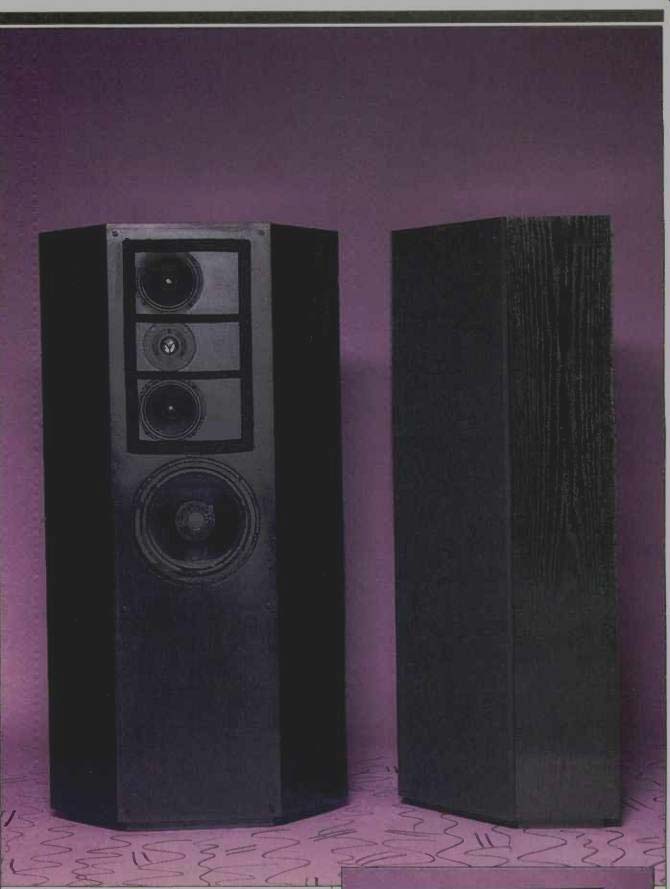

Manufacturer's Specifications
System Type: Four-way, floor-standing, closed-box system with rear-mounted subwoofer and tweeter.
Drivers: 10-in. rear-mounted cone subwoofer, 10-in. cone woofer, two 5 1/4-in. cone midrange drivers, one 1-in. metal-dome tweeter, and one rear-mounted 3/4-in. tweeter.
Frequency Response: 20 Hz to 20 kHz, ± 1.5 dB, with fifth-octave averaging; 100 Hz to 15 kHz, ±2 dB, 45° to either side of axis.
Total Radiated Power: 600 Hz to 18 kHz, ± 1 dB; 20 Hz to 18 kHz, ±3.5 dB.
Sensitivity: 86 dB at 1 meter with 1 watt (2.83 V rms) applied.
Acoustic Crossover Frequencies and Filter Slopes: 40 Hz (12-dB/octave low pass), 275 Hz (24 dB/octave), 2.7 kHz (18 dB/octave), 5 kHz (6-dB/octave high pass) for rear tweeter.
Impedance: 8 ohms average, 4 ohms minimum, 20.5 ohms maximum.
Maximum phase of +45° at 20 Hz.
Recommended Amplifier Power: 40 to 400 watts per channel.
Dimensions: 17 1/2 in. W x 48 in. H x 17 1/2 in D (44.5 cm. x 121.9 cm x 44.5 cm).
Weight: 125 lbs. (56.7 kg) for single system.
Price: $4,490 per pair. Available in light or dark oak, walnut, and black-finished veneers.
Company Address: 143 Essex St., Haverhill, Mass. 01832.
Snell has garnered a good reputation over the years for producing accurate-sounding systems with honest value for the money. Snell's first system, the Type A, the precursor of the Type B renewed here, was placed on the market shortly after Peter Snell founded the company in 1976. That system, currently in production as the Type A IIIi aid at the top of Snell's lineup, was one of the first systems to seriously consider the effects of room boundaries on low-frequency response.
When the company's founder passed away suddenly, in 1984, the yell family turned management of the company over to its current president, Dr. William Osgood, who had long been a management consultant to Snell. The Type A's designer, Kevin Voecks, joined the company in 1985 and currently directs its engineering and design efforts.
The Type A is unique in that it utilizes two woofers mounted at widely different cabinet locations; this is said to smooth the bass response of the system in typical listening rooms. One forward-facing woofer is mounted on the front, bottom half of the cabinet, while the other is mounted on the top of the cabinet's rear and faces 45° to the side (toward the center of the room, not the walls). The front woofer has flat response from crossover down to about 50 Hz, while a separate low-pass filter lets the rear woofer fill in the response below about 50 or 60 Hz. At the low frequencies where both 10-inch woofers operate essentially in parallel, they have approximately the air-moving capability of a single 15-inch driver.
Because the woofers are different distances from the room's boundaries, the total radiated acoustic power should be smoother (at least in theory). For example, if one woofer has a null in its response at the listening location, the other woofer should partially fill this null because it operates from a some what different source location, with a different effect on its room response. The Type B's cabinet is five-sided and is formed by essentially lopping one corner off a conventional square-shaped cabinet. The "cut" surface is used to mount the front-facing drivers. The rear woofer and tweeter are then mounted on one of the remaining 45° rear-facing panels. The resultant structure is stronger than the original box and potentially has fewer problems with internal standing waves.
The front driver complement includes one 10-inch woofer, plus a dome tweeter centrally mounted be tween two 5 1/4-inch midrange drivers, in a "D'Appolito" configuration (named after Joseph D'Appolito, a contributing editor of Speaker Builder magazine, who first gave a detailed description of the configuration). The major benefits claimed for this configuration include greater vertical directivity (which reduces floor and ceiling reflection effects), an absence of lobing error, symmetrical up-down polar response, greater acoustic output capability, and lower distortion. The rear tweeter, which can be turned on and off with a rear-mounted switch, provides fill in the top octave of the system. This is to flatten the power response, which would otherwise roll off due to the front tweeter's narrowing coverage.
A rear connection panel provides mounting for a pair of bi-wirable, five way input binding posts (with a pair of heavy copper straps for single input connection), a tweeter fuse, a level control for the front tweeter, and the switch that controls the rear tweeter. Each Model B has two grilles, a top-to-bottom unit for the front and a smaller one for the rear. The front tweeter and midranges are surrounded by strips of felt that minimize diffraction when the grille is mounted.
High-slope crossovers are used throughout to minimize driver interaction. The system has been optimized not only for flat on-axis response, but for uniform off-axis response and power response as well. This uniformity ensures that the reflected and reverberant sound fields have the same tonality and spectral content as the direct sound.
Snell is one of the few American companies to use the facilities of Canada's National Research Council (NRC) in the design and measurement of their systems (see Audio Sept. 1989 for a description of the NRC facilities). Extensive NRC double-blind listening tests were used in designing the Type B, which evolved over a three-year period, Snell provided a complete set of the NRC test results, and my test measurements were quite close to the NRC results.
Measurements
The Type B presented a significant measurement challenge due to its large size and odd shape. Because the speaker cannot be laid flat on its side (in this orientation, the speaker's two lower sides are each at 45° to the ground rather than flat against it), I had to make up wooden test jigs just to hold it in this position for the ground-plane and vertical off-axis curves. The speaker's size and weight also forced me to run the vertical off-axis curves on the ground plane, rather than with the speaker raised to its usual height.
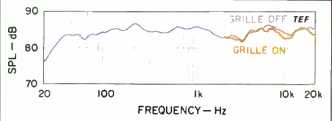
Fig. 1-One-meter, on-axis frequency response.
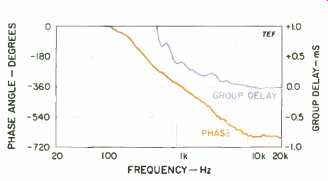
Fig. 2-On-axis phase response and group delay.
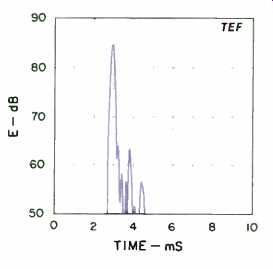
Fig. 3-Energy/time curve.
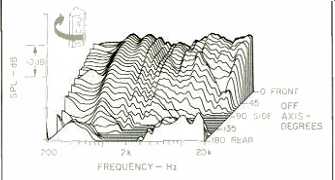
Fig. 4-Horizontal off-axis frequency responses.
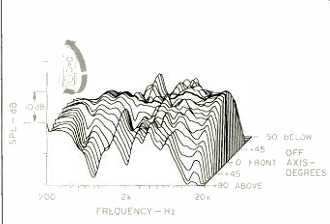
Fig. 5-Vertical off-axis responses.
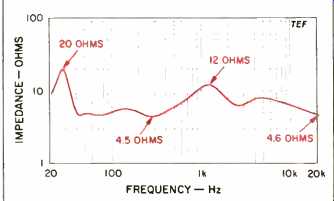
Fig. 6--Impedance.
The on-axis anechoic frequency response of the Type B, with and without the front grille, is shown in Fig. 1. The tweeter level control was in the straight-up position, as Snell recommends. Measurements were taken on the tweeter axis, at a distance of 2 meters with 5.66 V rms applied, and then referenced back to 1 meter. The response below 300 Hz was derived from 2-meter ground-plane measurements with input reduced to 2.83 V rms to compensate for the ground plane's 6-dB boost. Sensitivity was a bit low, at an average 84.3 dB (1.7 dB lower than specified) over the range from 250 Hz to 4 kHz.
The on-axis curve is well behaved and quite extended. The response does not meet its very narrow ± 1.5 dB specification, but it still fits within a tight ±2.3 dB window from 30 Hz to 20 kHz. In the Type B, the 12-dB/octave roll-off typical of sealed-box speakers occurs below 30 Hz, and response at 20 Hz is down only about 10 dB from the 1-kHz level. Other than minor response irregularities, the only distinguishing feature of the curve is a slight depression in the response around the upper, 2.7-kHz, crossover. A separate measurement of the rear tweeter revealed that its output rises at 6 dB per octave and attains the same level as the front tweeter above 12 kHz.
Above 100 Hz, the right and left systems were matched within ± 1 dB. The front grille only caused minor irregularities in the axial response above 2 kHz. Measurements show that the tweeter level control provides approximately ±2.5 dB of adjustment range above 2 kHz. All the following measurements were taken with the grilles off and the tweeter level control in the straight-up position, unless otherwise noted.
The phase and group delay responses of the Type B, referenced to the tweeter's arrival time, are shown in Fig. 2. The phase curve rotates a significant 280° between 1 kHz and 20 kHz due to the midrange/tweeter acoustic-center offset and the cross over design. The group delay is quite well behaved but increases as frequency decreases.
Figure 3 shows the system's energy/ time response (ETC), measured at 1 meter on axis for a 2.83-V input. The test parameters were chosen to accentuate the response in the region from 1 to 10 kHz, which includes the upper crossover region. The main arrival, at 3 mS, is quite compact and is followed by only a single significant delayed arrival, about 22 dB down.
In Fig. 4, the horizontal "3-D" off-axis responses of the Type B are shown.
The bold curve at the rear of the graph is the on-axis response. Because the on-axis ripples in the response are carried over quite faithfully into the off-axis curves, the horizontal coverage of the Type B is excellent. However, a moderate peak in the off-axis response at about 16 kHz indicates broadening tweeter coverage in this range.
The rotation direction included the rear panel containing the rear tweeter.
Its contribution can be seen in the right front of the graph between 150° and 180°. The rear tweeter's level looks somewhat reduced in the figure be cause the time window chosen for the measurement attenuates signals that don't coincide in time with the direct sound from the front tweeter. Normally, this just reduces the effects of undesired reflections in the measuring environment, but here it also reduces the reading from the tweeter whose signal follows a longer path.
Figure 5 shows response above and below the vertical axis. The bold curve halfway back, marked 0°, shows response on the tweeter's axis. The system exhibits very good behavior in the main coverage window, within ± 10° of the axis. A top-down contour view of the curves (not shown) revealed that the system's vertical coverage above 600 Hz is extremely symmetrical about the tweeter's axis, a highly desirable trait. This symmetry is a direct result of the tweeter's central mounting between two identical midrange drivers.
The off-axis curves are rougher and not as well behaved as the corresponding horizontal off-axis curves, due to the more complex directional behavior of the two vertically stacked midranges.
No significant cabinet resonances were evident when the system was subjected to a high-level, low-frequency sine-wave sweep. However, some motion of the angled panel holding the subwoofer and tweeter was noticeable between 170 and 250 Hz at high levels. The woofers handled a healthy 20 V rms (50 watts) below 30 Hz without any stressful noises and did not exhibit any dynamic offset effects. The excursion of the woofers, with 20 V rms at 20 Hz applied, was a substantial 1 inch, peak to peak! But when the level was raised significantly higher, the woofers bottomed, with unpleasant cracking and snapping sounds. At excursion levels out to about 0.6 inch peak to peak, the woofers were quite linear.
The sine-wave sweep revealed that the excursion of the rear-mounted sub-woofer reached a maximum at 35 Hz, where its displacement actually exceeded the front woofer's by about 20%. At higher frequencies, the rear woofer's excursion was much less than the front woofer's. Below 30 Hz, the excursion of both woofers was constant with frequency, with the rear's amplitude slightly less than the front. Near-field woofer curves (not shown), disclosed the front woofer was flat down to about 40 Hz where it rolled off at 12 dB/octave. The rear sub-woofer exhibited a moderate-Q (0 is 2.1, which equals center frequency di vided by the 3-dB bandwidth), 38-Hz fourth-order bandpass response that rolled off at 12 dB/octave at higher and lower frequencies. At 38 Hz, the sub-woofer's level was about 2.5 dB higher than the front woofer's. The near-field phase curves indicated that woofers were essentially in phase with each other below 40 Hz; this will result in increased total output.
The cabinet is divided into two chambers. The front woofer and cross over are mounted in the bottom cavity, which is about twice the volume of the top chamber where the rear subwoofer and remaining components are mounted. In addition, the midranges are mounted in separate, tubular sub-enclosures, each 6 inches long and with a 4 1/2-inch inside diameter. The sealed-back tweeter needs no separate enclosure. The larger bottom chamber is strengthened by an internal shelf brace formed of a 3/4-inch panel with large holes cut out for passage of air.
The front panel of the Type B is a substantial 1 1/4 inches thick. The remaining portions of the cabinet are made from 3/4-inch multi-density fiber board. The inside of both of these sub-enclosures are completely filled with a quantity of fiberglass 'or some similar absorption material.
The crossover of the Type B is composed of three separate sub-assemblies mounted in the larger bottom en closure. The five-way crossover (three for the front speakers and two for the rear) is fairly complicated and consists of 22 components: Six inductors, eight capacitors, six resistors, a tweeter level control, and a rear tweeter switch.
Actual parts count was significantly higher due to paralleled capacitors. Mylar capacitors are used to bypass all the higher-value, non-polarized, electrolytic capacitors. The subwoofer inductor is a huge 35-mH iron-cored part. The quality of all parts is high. All driver connections use heavy-gauge Monster Cable wire and are soldered. All crossover parts are wired point to point without the use of printed-circuit boards.

Fig. 7-Complex impedance.

Fig. 8-Three-meter room response.
The crossover consists of second-order, 12-dB/octave low-pass filters for the two woofers (at 40 Hz for the rear woofer and 275 Hz for the front one), a midrange bandpass composed of a third-order, 18-dB/octave high-pass filter cascaded with second-order, 12 dB/octave low-pass filter, and a third-order, 18-dB/octave high-pass filter driving the front tweeter. The rear tweeter is driven through a 12-dB/octave high-pass filter and an on-off switch. (These are electrical measurements of the filters alone; the manufacturer's specs are for acoustic output, which also includes roll-offs imposed by the drivers themselves.) All drivers are custom made for Snell by Vita of Denmark and utilize such features as polypropylene cones, cast frames, and Ferrofluid-cooled tweeter coils. Bi-wire connections allow the two woofers to be driven separately from the rest of the system.
The Type B's impedance magnitude is shown in Fig. 6. The curve was run with the rear tweeter on and the front tweeter level control in the straight-up position. An easy-to-handle minimum impedance of about 4.5 ohms occurs at 290 Hz and at 20 kHz. The impedance reaches a maximum of 20 ohms at the closed-box resonance of 29 Hz.
With the rear tweeter switched off, the system's impedance rises above 5 kHz instead of falling, and reaches a value of about 10 ohms at 20 kHz. With the tweeter level control at its highest position (full CW), the system's impedance above 1.6 kHz falls somewhat, though no lower than 4.4 ohms, and it rises a bit when the control is turned all the way down.
The curve has a max/min variation of about 4.4:1 (equal to 20/4.5) and thus will be only moderately sensitive to cable resistance. Cable series resistance should be limited to a maximum of about 0.068 ohm (68 milliohms) to keep cable-drop effects from causing response peaks and dips greater than 0.1 dB. For a standard run of about 10 feet, 14-gauge or heavier wire should be used. Snell's manual states that all their speakers are designed to be used with cables having a resistance of 0.15 ohms. This strikes me as a bit high, but I'm pleased that Snell de signs with real cable properties in mind, and using cables of lower resistance (as I did) should do nothing more than raise output at resonance by a fraction of a decibel.
Complex impedance, plotted over the range from 5 Hz to 30 kHz, is shown in Fig. 7. The impedance phase angle (not shown) reached a maximum of +47° (inductive) at 18 Hz, and a minimum of-48° (capacitive) at 36 Hz. The Type B will not be a problem for any high-quality amplifier.
The Type B's 3-meter room curve is shown in Fig. 8 with both raw and sixth-octave smoothed responses. The system was in the right-hand stereo position, aimed at the listening location, and the test microphone was placed at ear height (36 inches) at the listener's position on the sofa. The direct sound and 13 mS of the room's reverberation are included. Between 2 and 20 kHz the smoothed curve is quite well behaved and closely follows the on-axis response. Excluding the upper-bass room-effect peak at 170 Hz, the curve nicely fits a 7.5 dB (±3.75 dB) window from 100 Hz to 20 kHz.
I also ran slow sweeps from 20 to 200 Hz (not shown) to check low-frequency response at the listening position and assess the effects of the two woofers individually. By alternately covering and uncovering the woofers, I determined that the main effect of the rear woofer was .an increase in total system output below 50 Hz. It did, however, partially fill in holes at deep dips in the curve made with only the front woofer operating, decreasing the depth of an 80-Hz dip by nearly 15 dB and making a 32-Hz dip significantly narrower without appreciably changing its depth.
Figures 9 and 10 show the single-frequency harmonic distortion spectra versus power for the musical notes of E1 (41.2 Hz) and A2 (110 Hz). Distortion for our usual 440-Hz tone (A4) is not shown because the only measurable distortion consisted of 1% second harmonic at full power. The power levels were computed using the rated system impedance of 8 ohms.
The E1 (41.2-Hz) harmonic distortion measurements (Fig. 9) were a bit peculiar because the second and third harmonics rose to intermediate maxi mums and then fell as the power was increased to 100 watts. The second harmonic, for example, reached 10.5% at 31 watts, but was only 3.5% at 100 watts. Curiously, at full power the fourth harmonic dominated, at 20%, with the second and third harmonics at 2.6% and 5.2% respectively. However, intermediate peaks of 10.5% second at 31 watts and 6.5% third at 63 watts were reached. Even though fairly high distortion values were attained in the E1 test, the generated distortion was not very objectionable, subjectively speaking. At 100 watts, the system generates a fairly loud 103 dB SPL at 1 meter at 41.2 Hz.
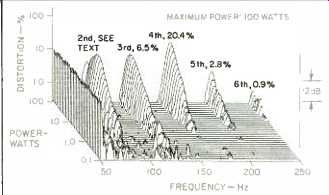
Fig. 9--Harmonic distortion for the musical tone E1 (41.2 Hz).
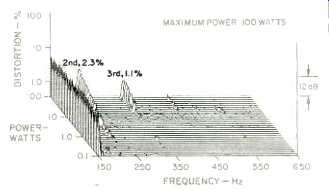
Fig. 10--Harmonic musical tone A2 (110 Hz).
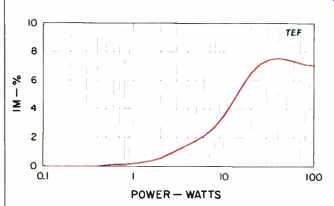
Fig. 11--1M distortion of 440 Hz (A4) and 41.2 Hz (E1) mixed in one-to-one
proportion.

Fig. 12--Maximum input power and peak sound output.
The A2 (110-Hz) harmonic data is shown in Fig. 10. The second harmonic reached only 2.5% at 100 watts, with the third reaching only 1.1%. At 110 Hz with 100 watts input, the system generates a moderately loud 104 dB SPL at 1 meter.
Figure 11 displays the IM created by tones of 440 Hz (A4) and 41.2 Hz (E1) of equal input power. The IM distortion rose only to the 7% to 8% range at full power. Interestingly, the IM distortion reached an intermediate peak of 7.5% at 40 watts and then fell to 7% at 100 watts. Overall, the Type B exhibited fairly high distortion in the E1 (41.2-Hz) harmonic measurement but reason able to low distortion values in the other measurements.
Figure 12 shows the short-term peak-power input and output capabilities of the system as a function of frequency, measured using a 6.5-cycle tone burst with third-octave bandwidth.
The peak input power rises with frequency, reaching 5,000 watts above 300 Hz, with only occasional pauses on the way. Some limiting between 1.6 and 3 kHz was evident, presumably due to tweeter excursion limitations in the bottom of its range.
The upper curve in Fig. 12 shows the maximum peak sound pressure levels the system can generate, at a distance of 1 meter on axis, for the input levels shown in the lower curve. Also shown is the "room gain" of a typical listening room at low frequencies, which adds about 3 dB to the response at 80 Hz and 9 dB at 20 Hz. The peak acoustic output rises rapidly with frequency up to 300 Hz, then essentially follows the ups and downs of the on-axis response from 118 to 122 dB SPL. With room gain, the system exceeds 110 dB above 40 Hz and 120 dB above 200 Hz. A stereo pair of speakers can reach even higher low-frequency levels with bass material common to both channels.
Use and Listening Tests
The Type Bs are quite large and imposing systems. At 125 lbs. each, they are a real challenge to unpack and set up. I managed to do it by myself, but it was pretty much the limit of what one person alone could accomplish. Once set up, they present a very massive and stately appearance.
The front of the speaker is essentially the edge left when one corner is lopped off a tall cabinet 17 1/2 inches square, and is the widest side of the speaker. While the manufacturer's specs say the cabinet is 17'/2 inches square, it's actually more like 25 inches wide and 17 1/2 inches deep. Even though the Snell Bs' cabinets are quite large, their comparatively small frontal area and the D'Appolito driver arrangement gives them the uniformity of vertical and horizontal coverage you'd expect from a much smaller system.
The systems are quite attractive, even in black-finished veneer, and should be even more attractive in real wood.
The set-up instructions provided with these speakers were generic to the whole Snell product line and did not cover anything specific to the Type Bs. Snell states that they are working on a manual for the Type B. The sup plied 17-page owner's manual, how ever, was very extensive and provided much detail in many areas including bi-wiring, bi-amping, and an excellent section on room acoustics.
The manual does not say which of the two cabinets should be on each side of the setup. A call to Snell revealed that the speakers should be set up so that each rear woofer/tweeter combination faces diagonally towards the center of the rear wall rather than with the rear drivers facing the room's outside wedge. (Remember that the rear of each system is actually a 90° wedge, with two surfaces at 45° angles to the rear wall.) I did not experiment with any alternate configurations. Al though spikes are provided, I did not use them because of the systems' large size and weight.
The high-frequency balance of the systems were most similar to my reference systems with the tweeter level control in the recommended straight-up position. I left it this way for most of my listening. The rear tweeter did lend a slight air of increased spaciousness to the sound of the systems. The rear of my listening room is somewhat more absorptive than a typical listening room and therefore attenuates some of the rear-directed high frequencies.
Most listening was done with the rear tweeter on.
Input connections are made to a very accessible set of heavy five-way binding posts mounted on 3/4-inch spacing. Listening was done both with and without bi-wiring using Straight Wire Maestro cables. Amplification consisted of the Jeff Rowland Consummate preamp and Crown Macro Reference power amp driven by the Onkyo and Rotel CD players. The speakers were spaced 8 feet apart and slightly toed in towards my listening area, about 10 feet away.
First listening revealed a smooth, de tailed response with excellent imaging, but with a somewhat reduced low end as compared to my reference systems.
I found this somewhat strange be cause of past experiences with the system at CES and elsewhere, where the low end was quite exemplary. This puzzled me, because Audio's editors in New York had had the opposite experience, finding the bass somewhat fat and overbearing, as had a reviewer at another magazine.
Further listening and tests revealed that the combination of my room and reference speakers was actually giving me a significant amount of emphasis in the mid- to upper-bass range, and I'd gotten used to this. High-resolution tests of low-frequency response indicated that, at my listening position, the Snells actually had a much flatter response. My reference systems exhibited greater output in the range from 30 to 75 Hz, but less output below. Excluding a sharp dip at 32 Hz, exhibited by both systems, the Snells actually had extended response all the way down to 10 Hz in my listening room (presumably, the Snell's closed-box design energizes my room in the pres sure mode below 20 Hz, while B & W's vented-box design rolls off quite rapidly below 20 Hz). At least in my listening room, whose walls are of conventional construction (plasterboard on 2 x 4-inch framing), Snell's design seems to deal with room boundaries very well indeed! The Type B's handling of complex orchestration was outstanding when playing Mozart: Sinfonia Concertante, K.364 and Concertone, K.190 ( Sony SK 47693). Instrument placement was quite vivid, which attests to the excellent imaging qualities of the Bs. The particularly demanding choral music of Mozart: Missa K. 47a and Mass K. 427 sung by the King's College Cambridge Choir (Argo/Decca 421 365-2) was rendered with good accuracy, cleanliness, and minimal strain.
The high-crest-factor rim shots on track 5 of The Sheffield Drum Record CD (Sheffield CD-14/20) were reproduced very cleanly at quite realistic levels. The level and input/output over load (IOC) indicators on the Crown Macro Reference power amplifier were put to good use here. I raised the level to the point where the IOC light lit momentarily at 4:40 into the track (where the highest peak occurs) and then listened to the rest of the track. This is a peak power of about 2,100 watts ( ± 130 peak volts across 8 ohms)! The Type Bs even did a smashing job of Alan Jackson's Don't Rock The Jukebox country/western CD (Arista ARCD-8681; if you've never tried a little C & W, try this one first; sounds super on high-end gear!).
The Type Bs passed the stand-up/sit-down pink-noise test quite handily with no significant changes in timbre, equaling the performance of my reference systems. On third-octave, band-limited pink noise, the Bs also equaled the performance of my references in generating low frequencies. The only significant differences were that the B & W system's vented boxes produced some chuffing sounds while the Snells had somewhat more harmonic distortion, especially at the third-octaves centered on 20, 25, and 31 Hz. The fundamental air-moving capabilities of the two systems were pretty much the same, as evidenced by doors and windows rattling on the lowest bands.
I did succeed in bottoming out the woofers of the Type B by playing the notorious cannon shot on Tchaikovsky: "1812" Overture (Telarc CD-80041).
Even though the woofers sounded quite (make that very) distressed, I believe I did no damage.
All things considered, the Type Bs performed quite flawlessly for me. As compared to my reference systems, which cost significantly more, they did an extremely good job, even surpassing them in some circumstances. Im aging, uniformity of response, accuracy, dynamic range, and appearance were all first-rate. The two-woofer low-frequency design worked very well with the acoustics of my listening room.
One improvement that could be made, however, would be to reduce the woofers' low-frequency harmonic-distortion level.
-D.B. Keele, Jr.
(Source: Audio magazine, sept. 1992)
Also see:
Soundwave Point Source 3.0 Speaker (Equip. Profile, Jan. 1995)
Vandersteen 2Ci Speaker (Equip. Profile, Jun. 1992)
= = = =